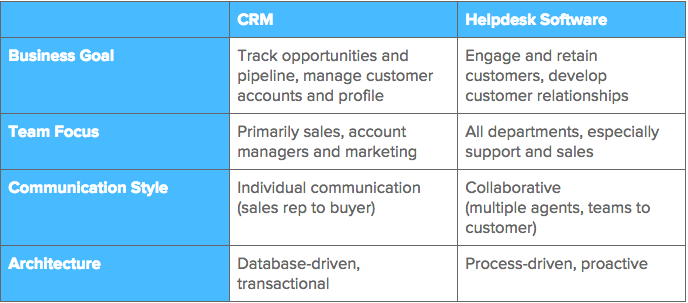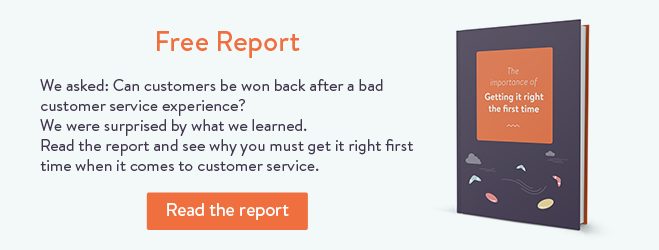A help desk software enables customer care operators to keep track of customer requests and deal with their issues. For a software to be considered a help desk it needs to consist of at least 3 elements: ticket management, automation suite, and have a reporting capability.
One of the most common questions we receive when we tell potential customers we are a helpdesk software: “Is that like a CRM?” It can be a tricky question to answer, but this breakdown will help you understand how helpdesks work with CRMs and the three distinct ways companies use them.
Is it a helpdesk or a CRM?
This is radically oversimplified, but think of them as two overlapping categories anchored by the customer’s profile and history. CRMs focus around sales and accounts. Helpdesks focus on engagement and conversation.
CRMs typically don’t have functionality for collaborative inboxes and engagement — and this is why a helpdesk is a must-have for your organization. They play together, but let’s understand first how they complement each other.
How do you use a helpdesk?
A customer service platform that covers your customer touchpoints – email, phone, chat, social media, and so on – and pulls each of them into your helpdesk as a ticket (or case). A helpdesk is a hub for communicating with your customers. From there, it’s your task to resolve and respond to each ticket in your system.
Beyond that, there are many ways you can use a helpdesk, from the simple to the sophisticated. Here are the 3 major ways businesses are using helpdesks:
1. As a traditional support desk
The first helpdesks were designed for functionality, in-and-out style.
Traditional support was designed to be reactive: to track and fix issues as customers reported them to get them back up and running. End of interaction. That translates into a very simple use case:
Customers are reporting bugs and incidents at the same time:
Log incidents in a queue, fix/ forward them and mark as resolved.
The traditional helpdesk has one other useful benefit: it helps support teams maintain a service level agreement (SLA). An SLA is a contract between a service provider (the support team) and the customer that defines the level of service expected from the support team. It ensures you’re responding to each ticket by a certain deadline. The helpdesk can process the number of incidents reported along with response times over a month (or a year).
This is the most common and obvious use for a helpdesk for businesses whose customer support needs are relatively static.
2. As a service desk
The service desk was the first time both support and businesses had a single view of their customers.
The service desk supports not just tickets, but workflows. Like an operations center, the service desk keeps an entire organization humming along. It powers the workflows of any team, which means an HR team can engage with candidates while the IT team handles support requests. The service desk solves many of the problems organizations face as they scale and their operations become increasingly complex:
Getting cc’ed on too many emails without context:
The service desk gives you customer history and past behaviors.
Repeatedly answering the same inquiries:
The service desk lets you pull in templated answers to pull together a quick response.
Manually redirecting or assigning each ticket:
The service desk lets you automatically filter and forward certain inquiries to the right person or team. For example, you should be able to send all technical inquiries straight to your technical support.
Account managers are out of the loop about why customers are contacting support:
The service desk can be set up to CC the account manager whenever a customer gets in touch with support.
The service desk also usually includes a knowledge base, which serves as a searchable user manual, with how-to and explanatory articles, usually written to help customers troubleshoot and fix problems themselves.
A service desk is still limited though, and very reactive. It takes something to trigger a workflow – a customer submitting a ticket, a subscription set to expire, a newly made contact, and so on. The service desk helps businesses tie customer service into their overall strategic goals.
3. As an all-company customer service platform
What if every person at your company could directly reach out to your customers before they ever contact you?
This is the idea behind an increasingly support-driven marketplace. The rise of the subscription-based economy – where customers can instantly jump ship and move on to a competitor – has turned the tables on reactive customer service. A reactive business waits for customers to request support. A proactive business has a success and enablement plan from Day 1, working on questions like “why” and “how”:
Leads and potential customers are dropping off instead of converting or buying
Identify and contact disengaged customers and offer to set up a session to help them use the product.
Customers who tweet for help are asked to send an email, resulting in multiple tickets and inconsistencies
All communication falls into a single inbox, so teams view incoming messages consistently regardless of channel.
Customers aren’t implementing the newest features available to them
Identify and personally reach out to customers who have fallen behind to help them update or upgrade.
Customers are not renewing their subscriptions or moving off.
Identify and personally reach out to customers who have fallen behind to help them update or upgrade.
These companies are venturing out from technology-driven to process-driven customer relationships.
Shared team inboxes help teams across the business collaborate from the same hub, accessing the same single customer history. With all conversations in one place, there are no department silos.
For the first time, your customers don’t need to flag a problem to get your attention. Your support team can send an outbound message without creating a ticket. You can just check in with customers every so often to engage them.
You might have sales, support and dev working together to enable a customer. You might use shared team inboxes to onboard and initiate them into their product or service.
The Takeaway
You don’t need to know what kind of helpdesk you want, but as you can see, you do need to know what kind of support experience you want to create.
Most businesses invest in a CRM at a much earlier stage of their business, while they’re busy acquiring leads and closing sales. The need for a helpdesk sneaks up on them once they have their customers, and these customers require more attention than a CRM can handle. If you’re clear on what kind of customer experience you want to provide, the path to your perfect helpdesk is a clear one.



